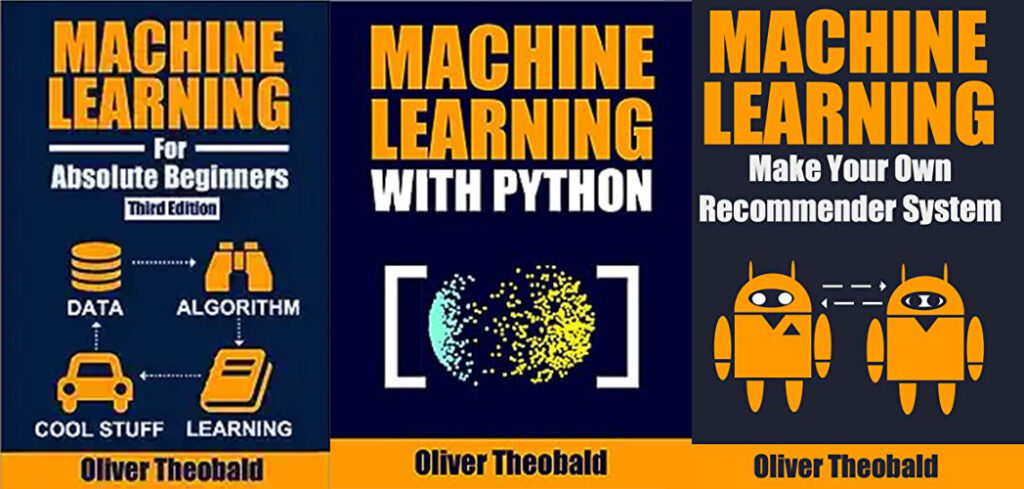To all aspiring programmers eager to enter the exciting world of Artificial Intelligence development, I want to extend my heartfelt encouragement and support. Embracing AI is a remarkable journey that promises to shape the future in unimaginable ways. With your passion for coding and the determination to learn, you are well-equipped to embark on this transformative path. Embrace the challenges and complexities with curiosity, for they are the stepping stones to innovation. AI development offers the opportunity to create cutting-edge solutions that can revolutionize industries and improve lives globally. Just like authors like Oliver Theobald who’s books I list a bit later. Your contribution to this field has the potential to make a profound impact on society. Stay curious, stay hungry for knowledge, and never shy away from exploring new possibilities. As you dive into the depths of AI, remember that every line of code you write brings us closer to a more intelligent, empathetic, and inclusive world. Your dedication to mastering AI development is commendable, and I believe in your potential to be an AI trailblazer. Welcome to the extraordinary journey of shaping the future with Artificial Intelligence!
To enable machine learning (ML) applications, specific code and infrastructure are essential components of the overall system. Below, we’ll discuss the key elements needed for successful machine learning implementations:
- Programming Languages and Libraries: Machine learning code is typically written in languages such as Python or R, as they offer extensive libraries like TensorFlow, PyTorch, and scikit-learn, which provide tools for creating, training, and evaluating ML models efficiently.
- Data Preprocessing Code: Before feeding data into ML models, it often requires preprocessing to clean, transform, and normalize the data. This code handles tasks like missing value imputation, feature scaling, and data transformation to make it suitable for ML algorithms.
- Model Training Code: This segment contains the code that defines the ML model architecture, selects appropriate hyperparameters, and performs the training process on the training dataset. This code usually involves defining the neural network layers, loss functions, and optimization algorithms.
- Model Evaluation Code: Once the model is trained, evaluation code is essential to assess its performance on unseen data. It involves metrics like accuracy, precision, recall, or F1-score to measure the model’s effectiveness.
- Deployment Code: For real-world applications, machine learning models need to be deployed and integrated into the existing infrastructure. Deployment code ensures that the model is accessible via APIs or other methods, making predictions based on new data.
- Data Storage and Management: Infrastructure requirements include appropriate databases or data storage systems to handle large datasets. This might involve traditional relational databases or NoSQL databases for unstructured data.
- Computational Resources: Machine learning often requires significant computational power, especially for complex models and large datasets. Cloud-based solutions like AWS, Google Cloud, or Azure offer scalable resources to handle ML workloads effectively.
- GPU and TPU Acceleration: Training deep learning models can be computationally intensive, and Graphics Processing Units (GPUs) or Tensor Processing Units (TPUs) provide specialized hardware acceleration, significantly speeding up model training times.
- Version Control: Machine learning models and code evolve over time, necessitating version control systems like Git to manage and track changes, allowing for collaboration among developers.
- Monitoring and Logging: For production systems, monitoring code tracks the model’s performance and logs relevant information to identify potential issues and ensure model accuracy and reliability.
- Security Measures: As ML models can be susceptible to adversarial attacks, appropriate security measures are vital to safeguard against potential threats and protect sensitive data.
- Continuous Integration/Continuous Deployment (CI/CD) Pipelines: These pipelines automate the process of testing and deploying new model versions, ensuring that changes are rolled out efficiently and reliably.
The combination of robust code and a well-architected infrastructure is crucial for successful machine learning applications. It enables efficient model development, deployment, and management, ultimately contributing to the effective utilization of ML in various domains, from image recognition and natural language processing to predictive analytics and recommendation systems.
There are many resources for you to dig into but please let me feed you a few. The following 3 books from Oliver Theobald are great start series.
- Machine Learning for Absolute Beginners: A Plain English Introduction (Third Edition) (Machine Learning with Python for Beginners)
- Machine Learning with Python: A Practical Beginners’ Guide (Machine Learning with Python for Beginners Book 2)
- Machine Learning: Make Your Own Recommender System (Machine Learning with Python for Beginners Book 3)

Once you are done with them. Head over to our list of the ten best AI ML Learning resources on Audible.
1 2 3 4 5 6 9 AI AI news ant art Artificial Intelligence automation borrow borrow a minute chatgpt coffee break Control Fiction fire water bean fiscal responsibility hit how many minutes How many minutes in a day how many minutes in a month how many minutes in a week how many minutes in a year Immersive Innovation ISS Machine Learning mental break minute fiction minute read model R rain risk SaaS short blog short story skannar story Trust where am I now


